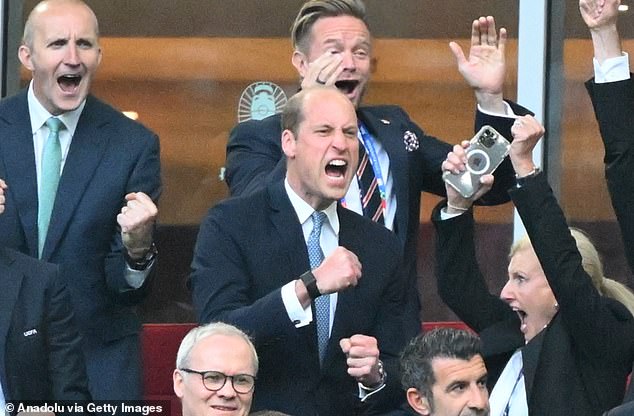In a surprising twist in royal affairs, Prince William‘s ambitions for the monarchy are encountering unexpected resistance.
As headlines proclaim his royal aspirations are under scrutiny, it seems that even a future king isn’t immune to public criticism.
In this era of heightened expectations, William finds himself navigating a complex landscape where the traditional image of royalty is being challenged.
So, what’s causing this stir, and why are William’s plans receiving such mixed reactions?
Let’s unpack the intricacies of modern royalty and its evolving relationship with the public.
Being a prince might conjure images of an effortless life filled with privilege and adoration, but the reality is far more nuanced.
William, who has been prepared for this role since childhood, faces a myriad of challenges.
With media scrutiny at an all-time high and a public increasingly questioning the relevance of monarchy, the pressure mounts on him to make a meaningful impact.
The question looms: how can he ensure that his royal legacy resonates with a rapidly changing society?
To understand the current climate, we must consider the transformative effects of the digital age.
Social media has democratized communication, giving everyone a platform to voice opinions.
The departure of Prince Harry and Meghan Markle from royal duties sent shockwaves through the institution, sparking debates about the monarchy’s survival in an era that values transparency.
Can William carve out a niche that feels both contemporary and relatable amidst these shifting tides?
William’s initiatives—focusing on mental health, environmental sustainability, and community engagement—appear commendable at first glance.
However, the reception has been less than enthusiastic.
Why is that?
Perhaps the public craves action over mere words.
How can he align his royal responsibilities with the expectations of a populace that is growing more discerning and demanding?
One of William’s standout efforts has been his advocacy for mental health awareness.
He has openly shared his personal struggles, emphasizing the importance of mental well-being.
Yet, while many commend his initiatives, some question whether the royal family can genuinely connect with those facing mental health challenges.
Picture a young person scrolling through social media, watching William discuss mental health from a polished royal backdrop—it may feel distant, like a scene from a movie.
To bridge this gap, William could consider sharing more personal narratives or engaging directly with grassroots organizations.
Imagine him hosting informal chats in local cafes or community centers, bringing his message to the people in a more authentic manner.
Such interactions could foster a deeper connection, moving beyond the formalities typically associated with royal engagements.
Turning to his commitment to environmental sustainability, the urgency of this issue cannot be overstated.
Yet, the royal family’s historical ties to opulence raise questions about the sincerity of William’s environmental efforts.
It’s a stark contrast to see him advocating for sustainability while surrounded by lavish estates and vintage cars.
How can he reconcile this perceived disconnect and inspire genuine change?
Leading by example could be a game-changer for William.
Initiating campaigns to reduce waste at royal events or promoting local sustainable businesses might resonate more profoundly with the public.
By showcasing tangible steps toward environmental responsibility, he could illustrate that even those in positions of privilege can contribute to meaningful change.
William has expressed a desire to strengthen community ties, but how can he ensure this is more than just lip service?
Royal appearances often come across as scripted and formal, creating barriers between him and the public.
What if he rolled up his sleeves and got involved in local initiatives?
Envision Prince William volunteering at a community garden or participating in a neighborhood clean-up—such actions would send a powerful message of care and commitment.
To further engage the public, hosting town hall meetings could provide a platform for direct dialogue.
This would allow him to address community concerns and aspirations, dispelling the notion that royals are out of touch.
Wouldn’t it be refreshing to see him interact with everyday individuals, demonstrating that he is indeed part of the societal fabric?
In this fast-paced digital world, maintaining relevance is crucial.
While William has made strides in embracing social media, balancing tradition with modernity remains a challenge.
His attempts to connect with younger audiences have produced mixed results, highlighting the complexities of digital communication.
Royal memes may evoke laughter, but some view them as undermining the royal image.
How can he navigate this quirky aspect of modern interaction?
Perhaps embracing humor could further humanize him, making him more relatable.
Engaging with meme culture might offer a fresh avenue for connection, allowing him to resonate with younger generations authentically.
Imagine if he shared behind-the-scenes glimpses of royal life through casual videos or TikTok challenges—such content could bridge the gap between the monarchy and a younger audience.
As Prince William grapples with these public expectations, the path ahead is filled with both opportunities and challenges.
His ability to adapt and connect with the public will define not only his reign but also the future of the monarchy itself.
The question remains: can he successfully blend tradition with the demands of a modern society?
The world is watching closely, eager to see how this royal drama unfolds.










